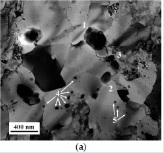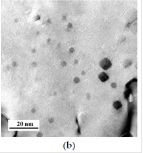
Alessandra Fava
University of Rome “Tor Vergataâ€, Italy
Title: Analysis of strengthening mechanisms in nano-ODS Steel depending on preparation route
Biography
Biography: Alessandra Fava
Abstract
Oxide dispersion strengthened (ODS) steels are promising materials for high temperature applications, in particular in fission and fusion nuclear reactors. In comparison to common reduced activation ferritic/martensitic steels they exhibit better resistance to neutron irradiation and creep owing to an uniform dispersion of nano-oxides particles (~ 5 nm) and a very fine grain structure (~ 500 nm). These features are shown in Figure 1.
ODS steels are commonly prepared by high-energy mechanical alloying (HEMA) of a mixture of steel powder and Y2O3 particles followed by a consolidation stage consisting of hot extrusion (HE) or hot isostatic pressing (HIP). The samples are then submitted to annealing around 1100 °C for 1-2 hours. Recently, the present authors proposed a novel method based on low-energy mechanical alloying (LEMA).
In general ODS microstructure is quite complex and several mechanisms contribute to the mechanical strengthening with different effects depending on the temperature. The present work analyses the role played by each single mechanism at increasing temperature by considering the specific microstructural features.
ODS steels prepared through different routes and process parameters display different grain size distribution and homogeneity of particles dispersion, factors which strongly affect the mechanical properties.
Yield stress values measured in tensile tests performed at increasing temperature up to 700 °C, either from literature or achieved by us, have been examined and the following strengthening mechanisms have been taken into account to fit the experimental data: (i) solid solution; (ii) Bailey-Hirsch; (iii) Hall-Petch; (iv) Orowan; (v) Arzt-RÅ‘sler-Wilkinson and (vi) Coble creep.
The analyses evidence advantages and drawbacks of different preparation routes and suggest some criteria for further improving the mechanical properties of these materials.


Figure 1: Fine grain structure (a) and nano-oxides particles (b).
Recent Publications
1. Zhao Q, Yu L, Liu Y, Huang Y, Ma Z, Li H, Wu J (2017) Microstructure and tensile properties of a 14Cr ODS ferritic steel. Materials Science and Engineering A 680:347-350.
2. Shen J, Li Y, Li F, Yang H, Zhao Z, Kano S, Matsukawa Y, Satoh Y, Abe H (2016) Microstructural characterization and strengthening mechanisms of a 12Cr-ODS steel. Materials Science and Engineering A 673:624-632.
3. Li Y, Shen J, Li F, Yang H, Kano S, Matsukawa Y, Satoh Y, Fu H, Abe H, Muroga T (2016) Effects of fabrication processing on the microstructure and mechanical properties of oxide dispersion strengthening steels. Materials Science & Engineering A 654: 203–212.
4. De Sanctis M, Fava A, Lovicu G, Montanari R, Richetta M, Testani C, Varone A (2017) Mechanical characterization of a nano-ODS steel prepared by low-energy mechanical alloying. Metals 7
5. Frelek-Kozak M, Kurpaska L, Wyszkowska E, Jagielski J, Jozwik I, Chmielewski M (2018) Evaluation of consolidation method on mechanical and structural properties of ODS RAF steel. Applied Surface Science 446:215-221.

